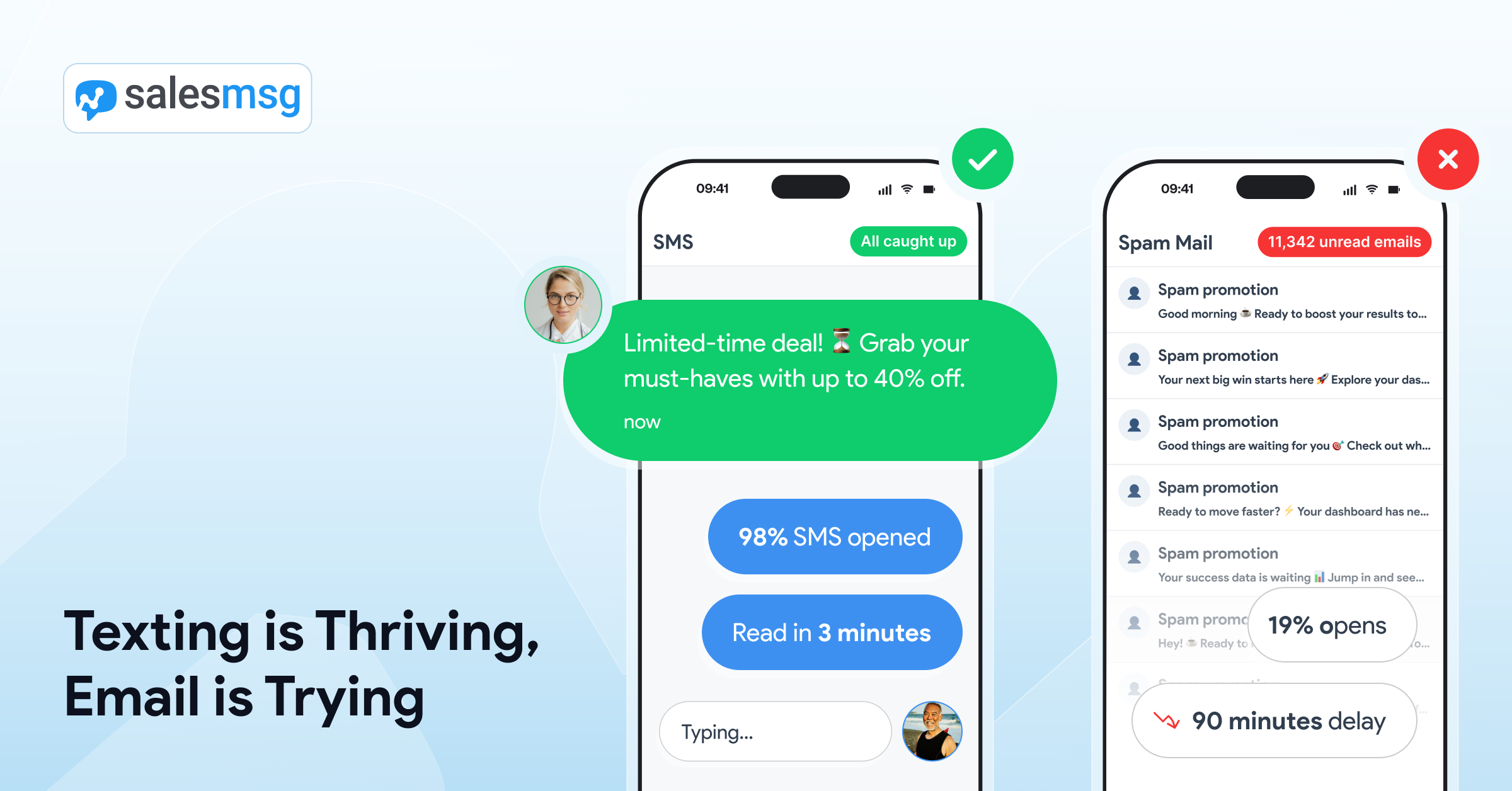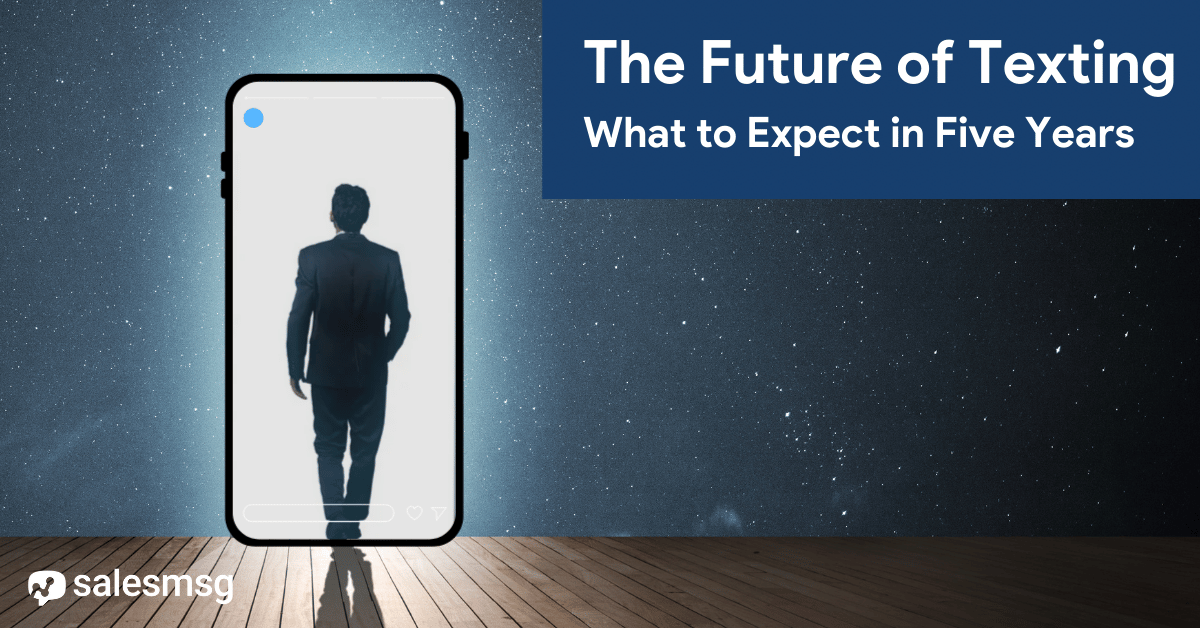SMS vs MMS: Which One is Best for Your Business?

Should your business use SMS or MMS messaging for a better ROI? Find out the differences between them and which one is the better option for your particular business.
Our fast-paced world tends to require us to be in constant communication. Seeing people tapping away on their phones, sending messages back and forth, isn't abnormal.
Sending text messages is a part of everyday life for most people. Have you ever thought about what types of messages you're sending and receiving? Probably not, so let's discuss them.
The two most popular types are MMS and SMS messages. SMS stands for Short Message Service and is a text-only message with a 160 character limit.
MMS stands for Multimedia Messaging Service and is more versatile. Sending MMS messages allows you to send videos, images, and other media files with a limit of 1600 characters.
The question remains, SMS vs MMS? Which one is best for your business? Each has their pros and cons, and in this article we’ll discuss in detail what they are, how to use them and which one would be better for your business.
What is SMS?
Short Message Service is more commonly known as “text-messaging” or “texts” and originated in 1980 as the standard texting technology allowing people to send messages to each other on cellular networks. Still popular today, 5 billion SMS messages are sent daily worldwide.
How Does SMS Work?
Standard SMS messages are text only messages with no file attached and are limited to 160 characters. An SMS can be sent and received from one mobile device to another and is transmitted through cell towers.
Advantages and Disadvantages of Using SMS
An SMS message is an ideal way of communication for some. It’s inexpensive, simple to create, and messages are sent and received quickly - as long as the sender and recipient have a good internet connection or cellular data.
Here are some pros and cons of using SMS for your business’s marketing campaign.
Advantages of Using SMS
- SMS marketing has a low cost, around 1 credit per message, which allows you to retain higher profits from your marketing efforts.
- Many subscription services offer unlimited messaging along with their paid plan which means your text subscribers won’t incur any extra cost.
- Since SMS messages are limited to 160 characters, they will be short and concise, requiring minimal effort in creating.
- SMS can reach more people as 70% of cell phone users use SMS and not everyone may have MMS enabled.
Disadvantages of Using SMS
- With no option to attach a file, including videos, audio and images, makes SMS a bad choice for promoting a product requiring any visual content.
- SMS messages have a character limit of 160 characters (including spaces) which can be limiting if you plan on sending longer, detailed messages.
- If your business operates in a foreign language, such as Chinese or Arabic, you may be further limited to only 70 characters, which means you may have to alter your strategy and shorten your message.
Watching the amount of characters you use is important, because if you exceed the limit, your messaging service may automatically convert your simple SMS messaging into MMS messaging.
Why is My Phone Sending MMS instead of SMS?
Sometimes you may unknowingly send an MMS instead of SMS. This can be worrisome if you intend to send a mass SMS as it could more than double the cost of your SMS marketing campaign. Your phone may be sending MMS messages if you’ve included media into your SMS or the length of your message has exceeded the word count.
What is MMS?
Multimedia Messaging Service is a more premium service when compared to the simple SMS message. MMS messages were developed with the same protocol of SMS but as a more enhanced version. By 2003, businesses began implementing MMS marketing campaigns due to the ability to send visual content directly to their customers.
The main difference between MMS and SMS is that with MMS you usually have an extended character limit of 1600 words (some services might provide unlimited characters) and can send images, videos, GIFs or audio files as well.
Since this is an upgraded version of the standard message service it costs more. But despite the costs many people still use it as a way to send more engaging content to recipients.
Advantages and Disadvantages of Using MMS
When choosing an appropriate strategy for your MMS marketing campaign you need to weigh the pros and cons to see whether they’re worth it.
Here are some benefits and drawbacks of using MMS.
Advantages of Using MMS:
- MMS messages are more engaging than SMS as people are more attracted to visual content than plain text messages.
- Using MMS is also great if you want to convey more detailed information to your customers, thanks to the ability to send more lengthy messages.
- One of the biggest advantages of MMS is the ability to send short video clips, images, audio files, and other forms of media.
Disadvantages of Using MMS:
- MMS is not as cost effective as SMS. If you plan on sending mass text messages to hundreds of potential customers, the cost can quickly add up.
- Some people don’t have MMS messaging enabled, which means they’ll be unable to receive your texts, wasting your money and time.
- You may need to hire someone to create your visual media content, like a graphic designer, thus increasing your cost further.
So, SMS vs MMS - Which is the Better Choice?
By now you should have a good idea of what SMS and MMS are and the differences between them. We've determined that both serve a different purpose and knowing which one to use for your business depends on several different factors.
Do you want to send a quick short message to lead your customers to follow through on a call to action? Then SMS messages might be the way to go. If you want to promote a new product and want to catch your viewer’s attention, an MMS message may give you better engagement and click-through rates.
Knowing which type of strategy is better for your business is crucial to maximizing your marketing efforts and ensuring the highest output.
In this section we’ll discuss in more detail what to look for when deciding on the appropriate marketing strategy and how you can use SMS and MMS messages for your marketing campaign.
Using SMS for Your Marketing Campaign
SMS marketing is the most common form of sending shorter and more important messages to your customers. These can be great for communicating information of a transactional intent like:
- Push notifications
- Reminders and updates
- Alerts
- Two-factor authentication
- Delivery tracking
- Text-to-join campaigns that require the user to reply to a message to sign-up
- Donations that require the user to send a message and input an amount
Using SMS marketing for the above cases will give you a higher open-rate than other marketing methods such as email and can convey important information quickly. Sending SMS messages is a more cost-effective option as they allow you to send more texts at a lesser price. Allowing you to reach a wider audience while keeping your costs low.
Standard carriers also allow you to send more SMS messages than MMS messages. If you expect to reach a lot of people and try to get a higher volume of people to sign up for your subscription service, then it makes more sense to use SMS vs MMS. You’ll be able to scale your SMS marketing and increase your customer base.
Depending on the nature of your business, SMS marketing may sound perfect. If it doesn't, it's worth looking into how MMS marketing campaigns may be the better fit.
Using MMS for Your Marketing Campaign
MMS messages allow you to attach media files to your text, which makes it much more engaging to customers. Using Multimedia Messaging Service also reports a 10-15% higher engagement rate than SMS messages and are 43% more successful than plain text messages.
MMS messages are great for your business for the following use cases:
- Present your product, its features and benefits
- Promote an event through the use of images
- Invite subscribers to an in-person event
- Send special celebratory messages
- Offer coupons
- Sending animations, like animated cards
- Sending detailed information about your business
An MMS marketing campaign is great for promoting new products and services. You can send people a video of how your product works and promotional images to show off impressive features. Sending the actual visual of the product can lead to a better, more engaged customer base as many wouldn’t click on a random product link and would much prefer getting a glimpse of the product first. This is also why MMS messages have a higher click-through-rate than SMS messages.
MMS campaigns are also ideal for sending more detailed information as some subscription services offer you a higher character limit compared to SMS messages; however, sending MMS is a lot more costly than sending SMS. Where a standard plan may allow you to send 1000 simple text only messages to your customers, you may only be able to send 300-500 MMS messages for the same price - some plans may even give you unlimited texting through SMS. Despite this price difference, many marketers report a positive ROI from MMS compared to SMS.
Should I Use Both SMS Messages and MMS Messages for My Marketing Campaign?
It’s common for most businesses to send a mix of SMS messages and MMS messages to promote certain aspects of their brand, although it comes down to your marketing objectives and what you hope to achieve. Using both messaging services can allow you to A/B test which works better for your business.
To find out which one is best for your business, you may send a mix of SMS and MMS messages to your customers to see which one converts better and gives a better ROI.
Another way to use both SMS and MMS marketing is to be able to perform in all aspects of your business. For example, a brand may first send MMS messages to its customers to promote a sale in their store. That same brand can then use SMS messages as a reminder to alert people to buy the product before the sale ends, which may give them a sense of urgency, leading to higher engagement rates and eventually more sales.
In this way, businesses balance out the costs and engagement of their brand and spread the risk. Rather than focusing on just one marketing strategy, you can rely on two different campaigns.
Salesmsg has a helpful feature where you can track your links to keep an eye out for KPIs of your brand. With Salesmsg, you can track conversions, revenue and the performance of your texts. This will help you better judge which type of messages are giving you a more positive ROI, making your A/B testing much more efficient.
Excel in Your SMS and MMS Marketing with Salesmsg
Salesmsg is a two-way business text-messaging software which empowers business owners, marketers and managers to manage all their conversations on one simple platform.
It is trusted by big brands like HubSpot and Clickfunnels to help them streamline their SMS and MMS marketing efforts and was also voted as the 27th fastest growing company in the Southeast region by Inc. Salesmsg empowers business owners and marketers by increasing their customer base and getting more conversions.
Salesmsg has a lot of helpful features that can help you in sending and measuring SMS messages and MMS messages for your business.
Some of its features include unlimited contacts, A/B testing, private and shared inboxes and the ability to track KPIs to measure the ROI of your SMS vs MMS marketing.




















